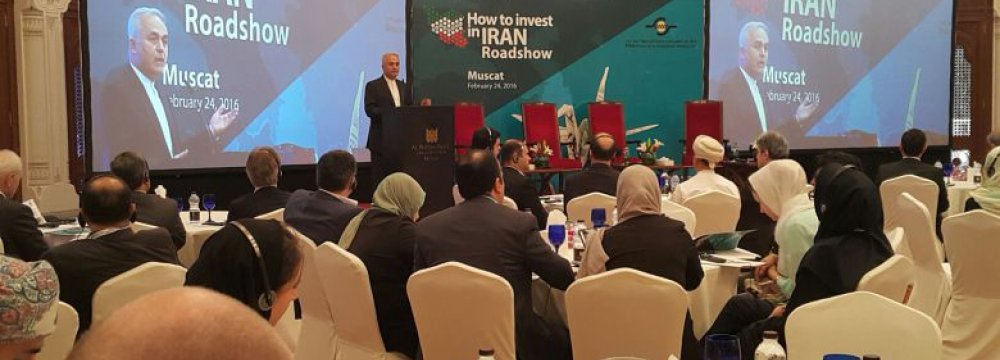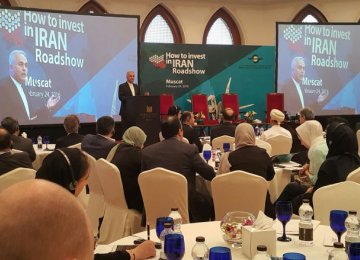Iran is targeting over $100 billion in foreign investments after nearly a decade of international economic sanctions that the country incurred for its nuclear program.
During its first roadshow since the lifting of the economic sanctions in January, which took place in last week in Muscat, Iranian officials also said they expected economic reforms to be introduced in the coming period—mostly to Iran’s financial sector—to attract foreign investors.
The targeted investments are “in the region of 25% of GDP [gross domestic product] which means over a $100 billion”, Ahmed Azizi, advisor to the governor of the Central Bank of Iran, told Newsweek Middle East on the sidelines of the conference in Oman.
Iran’s GDP, according to Azizi, is roughly over $400 billion, and while Tehran does not need to borrow money from the international market, since it has over $100 billion in assets that have been recently freed after the sanctions were lifted, “it is studying the possibility of issuing Islamic bonds” in the coming period.
“Iran has already received $50 billion of its frozen assets,” said Iran’s Ambassador to Oman, Ali Akbar Sibeveh, with “$50 billion more on their way to Iran”.
“We do need investments in sectors such as tourism and to develop our infrastructure,” said Sibeveh.
“Though we have been affected by the unjust sanctions, they were in fact a blessing in disguise,” he said, adding that sanctions helped Iran strengthen its economic and military sectors.
“Necessity is the mother of invention. Since we were slapped with sanctions and all doors were closed in our faces, we started manufacturing our products. Had it not been for those sanctions, Iran wouldn’t have developed. We are [now] the seventh [in the world] in nanotechnology,” he said.
Islamic Finance and Foreign Banks
“I’ve been told that there [are] studies to issue sukuk. The capacity is there and the country doesn’t need to tap the market for the current time, but it is good to establish the country in the market and to establish a track record,” he explained.
Islamic bonds in Iran are issued by local companies to cover the financial needs both in the private and public sector. The Islamic finance market in the country is considered the largest in the world with an estimated size of $500 billion, according to Iranian investors and officials.
With promises of economic and financial reforms, foreign banks have already submitted requests to open branches in the Islamic Republic, with Oman’s Bank Muscat being the first to apply.
“Bank Muscat is the first international branch to open in Tehran; it is the first [after the lifting of sanctions] but that doesn’t mean there aren’t other applications [from foreign banks],” Azizi said.
Oman has recently sent a high-level delegation to Tehran to discuss bilateral economic ties with Foreign Minister Yusef bin Alawi spearheading the delegation that included the sultanate’s commerce and industry minister and the executive president of the Central Bank of Oman.
Sibeveh told investors attending the roadshow in Muscat that his country made a mistake by placing all its eggs in the basket of one Persian Gulf state rather than diversifying and including Oman. It was not clear whether the ambassador meant the UAE or Qatar, whom Tehran continues to hold trade ties with.
Despite that, the ambassador said his country “will continue to extend a hand of cooperation and friendship to near and far friendly countries.”
In January, five of the six Arab Persian Gulf states, excluding Oman, severed or downsized their diplomatic ties with Tehran after the execution of a prominent Shia cleric by Riyadh led to attacks on Saudi Arabia’s diplomatic missions in Iran, including on the embassy in Tehran.
According to economists, Iran has recently managed to overcome its unprecedented point-to-point inflationary levels that hit 45% in 2013-15, bringing it to less than 10% last year.
“The inflationary history of the country is not very good. Annually it was at 30%, now it is 13%, and point-to-point inflation is less than 10%, so these numbers are below their historical trend,” said Azizi, who hoped “that with the reforms being on board in the future that these numbers would be brought further down”.
Stock Market
Tehran is set to welcome a large Turkish delegation this week from the Istanbul Stock Exchange to negotiate joint cooperation and dual listings among other market-related matters, Hassan Qalibaf-Asl, the CEO of Tehran Stock Exchange, told Newsweek Middle East.
Prior to the lifting of economic sanctions, Iran faced trade problems, as sanctions constituted a handicap to money transfer and banks’ transactions in the past. This has also impacted trading volumes and the size of the country’s stock exchange.
With a market cap of $100 billion and a market volume of $25 billion per year, which only comes from local investors, Qalibaf-Asl said, and the trade “could be much higher if foreign investors come to the country”.
Iran’s current ratio of market cap to GDP average is near to 30%, according to TSE’s CEO, while worldwide it is 100%. This shows the capacity of the market “so there is room to increase that in the future”, he added.
There are about 500 companies listed across 37 sectors in TSE and all are local companies.
The most recent listing was in mid-February where one petrochemical company was listed. TSE’s admission board admitted two new companies towards the end of February “one is big pharmaceutical company and the other is a food company,” said Qalibaf-Asl, adding that there were no current requests by foreign companies to list at the moment.
External Debt and Oil Production
The country, whose external debt, according to Sibeveh, stands at less than 2%, has a diversified economy with oil and gas contributing 15% to its GDP, a considerably low number compared to its oil-rich counterparts in the region where the hydrocarbon wealth’s contribution to GDP is sometimes as high as 90%, like in Qatar for example.
According to the Organization of Petroleum Exporting Countries, Iran holds the world’s third largest proven oil reserves of 157.53 billion barrels and the world’s second largest natural gas reserves, according to the Iranian government.
“The Iranian oil production has increased [recently] and will increase in future, but we are a member of OPEC and we should take into consideration the situation of the regional countries when it comes to production,” said Sibeveh.
Though the ambassador claimed his country supports and “welcomes” OPEC’s decision that all its members should freeze production for the time being, he noted “the current situation doesn’t help anyone. We hope that the oil market flourishes once again in favor of regional economies and oil producing countries”.
Iran’s Oil Minister Bijan Namdar Zanganeh had criticized the idea of Iran freezing its crude production to 1 million barrels a day, while hinting that Saudi Arabia produces over 10 million barrels of oil per day.
“It is a joke that they tell us they would freeze their production above 10 million barrels per day and that we should freeze our production at 1 million,” Zanganeh was quoted by Iran’s Press TV as saying.





